Leica X Vario: Electronic Viewfinder (EVF)
Introduction | (My) Criteria for Using an Electronic Viewfinder | My Experiences... | Issues | Final Word
Archive
On this page, I discuss the electronic viewfinder (EVF) for the Leica X Vario. The Leica version is called Visoflex 2 (or Leica Visoflex EVF 2 Electronic Accessory Viewfinder), while the identical Olympus version is called VF-2 (Olympus also builds the Leica version). Since I own the Olympus version (because it is cheaper), I can only write for this version, but I am confident that most of what I am writing here also accounts for the Leica version.
Note: I bought the VF-2 for the Leica X Vario und now use it for both cameras, the X Vario and the M (Typ 240).
Introduction
Leica writes in the X Vario manual: "The EVF 2 delivers almost
100% TTL reproduction of the image field with a resolution of 1.4 megapixels.
This allows easy and precise picture composition along with complete control
of all relevant data. It is particularly useful where the lighting conditions
impair the visibility of the monitor screen and - thanks to the tilting eyepiece
- for worm's eye view pictures.
The viewfinder is attached to the camera's flash shoe in the same
way as an external flash unit, which means the two cannot be used
together."
The Leica EVF 2 is manufactured by Olympus and said to be identical to the Olympus VF-2. Anyway, whatever differences there may be between the two, apart from the labels, both seem to work on the Leica X Vario (but see the issues section below). Here are a few views of the Olympus VF-2:
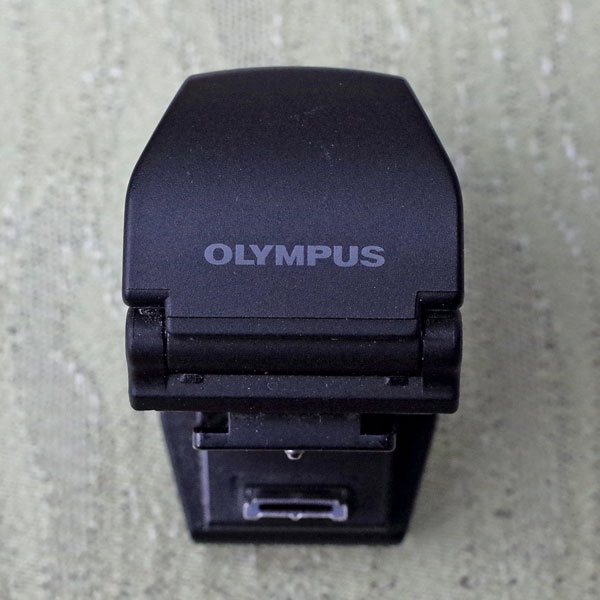 |
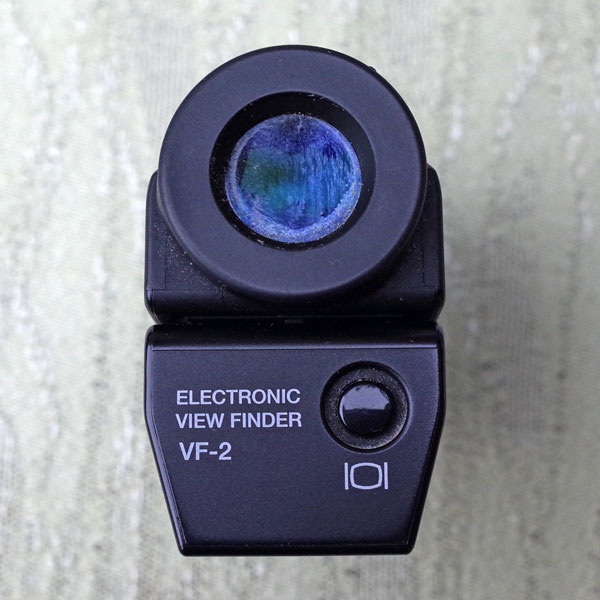 |
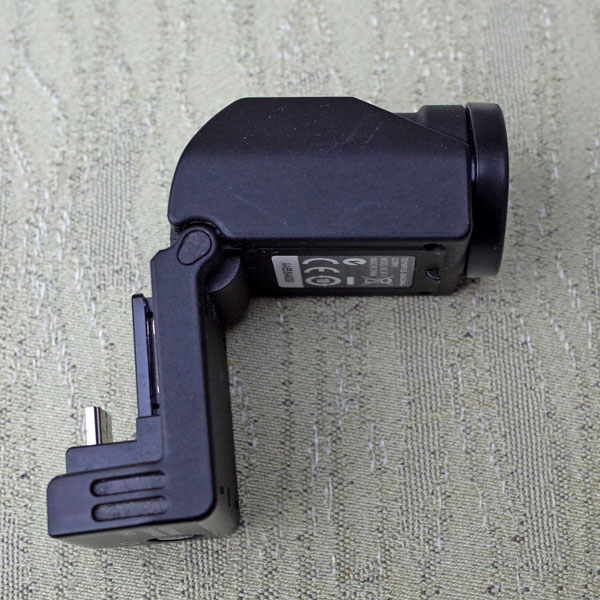 |
Figures: Views of the electronic viewfinder Olympus VF-2 (click images for larger versions in a new window)
The EVF shows the same section as the LCD screen on the camera back does, albeit at a higher resolution (1.4 vs. 0.9 megapixels). It has a button to switch between EVF and LCD screen. Moreover, you can set in the menus, which information is to be displayed on the LCD screen even when the EVF is turned on. You can also set various image parameters for both screen types, but I never used this feature.
The EVF is attached to the camera's flash shoe and makes the camera definitely larger (even more so if you tilt the EVF by 90 degrees).
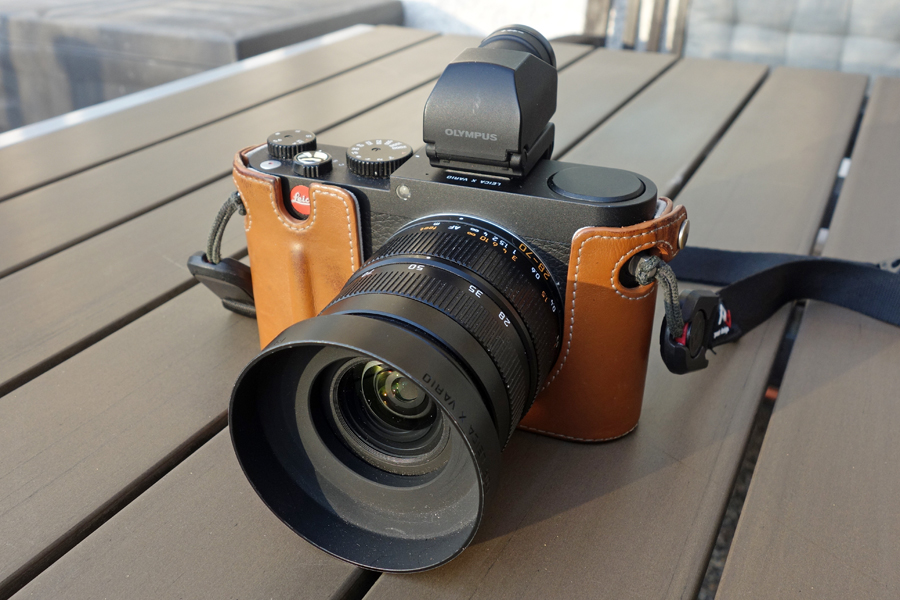 |
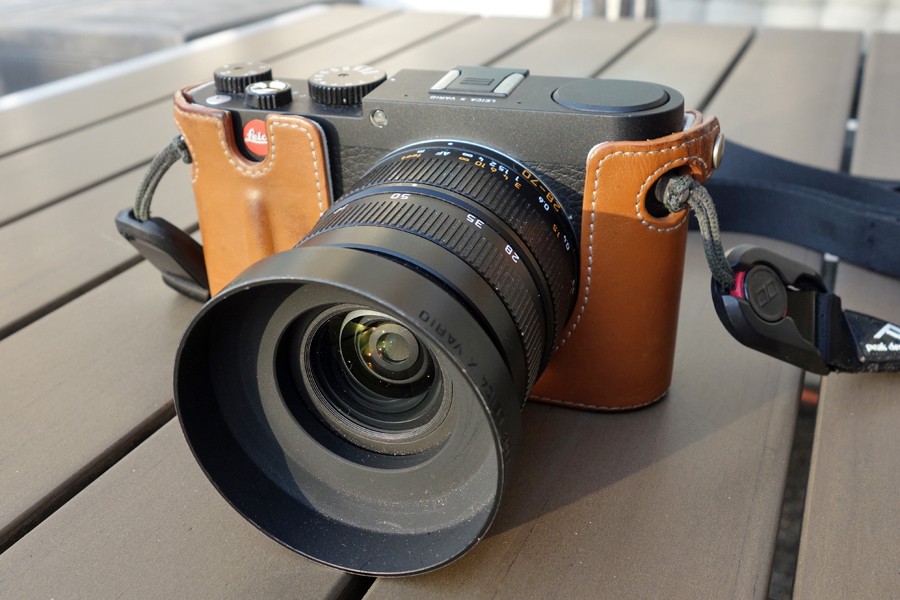 |
Figures: The Leica X Vario with and without electronic viewfinder Olympus VF-2
This also shows when you put the X Vario into a bag, as the following photos illustrate:
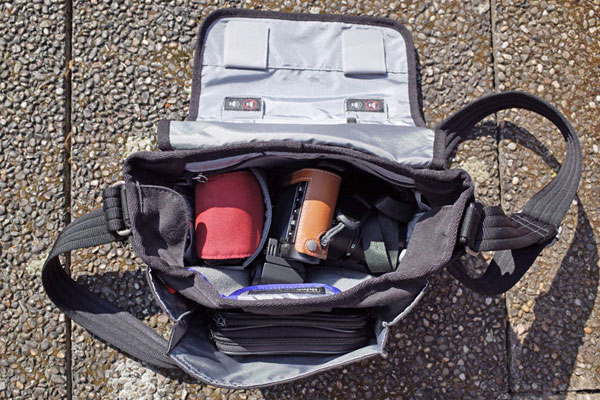


Figures: The attached viewfinder requires that the bag is soft so that the X Vario can fit into it (ThinkTank Retrospective 5 bag)

Figure: Without viewfinder, it's easier to put the X Vario into the bag (ThinkTank Retrospective 5 bag)
If your bag is, like my ThinkTank Retrospective 5, fairly small, it should be flexible enough so that it can "adapt" to the camera with attached viewfinder. On the other hand, removing the viewfinder every time you put the camera into the bag and attaching it when you take the camera out is too cumbersome for me...
To cut things short, I need a viewfinder, I prefer a tiltable electronic viewfinder, and therefore the remainder of the page just discusses, how well I fare with the electronic viewfinder for the Leica X Vario. There are two options, one from Leica (built by Olympus, and one from Olympus ( the differences should be neglegible) - and these are the only options available.
(My) Criteria for Using an Electronic Viewfinder
On the camera forums on the Internet, there are a lot of debates around electronic viewfinders such as:
- Do I need a viewfinder or can I do with the LCD screen? Why would I need one?
- Which viewfinder is better - an optical one, a rangefinder-type one like in a classic Leica, or an electronic one? Which are their specific advantages and disadvantages?
- What is better, a fixed viewfinder or an optional/attachable?
Actually, I do not want to repeat all theses debates here. In the following, I briefly summarize, why I use primarily an electronic viewfinder:
I prefer a viewfinder to the LCD screen because
- I am used to shooting with an viewfinder since my youth
- It saves me from putting on glasses (as I would need for an LCD screen)
- I can hold the camera more stable when I press it against my forehead instead of holding it at arm's length
- I feel that I can compose images better, when I use a viewfinder than when I use an LCD screen
For many years, I owned Minolta Dimage cameras which had electronic viewfinders. Then I switched to DSLRs with optical viewfinders and often found that I had forgotten to check the photo... So I decided to go for cameras with EVF again - despite the better image quality of the optical viewfinder and its speed (that is, there are no delays introduced by the electronics).
I prefer an electronic viewfinder to an optical viewfinder because
- I can see how the image will turn out before shooting (depending on the quality of the exposure simulation - and you may need some training for this...)
- I need not look at the LCD screen after shooting to check whether the photo is OK (exposure, sharpness, section, ...)
Provided it is tiltable, I prefer and optional/attached viewfinder to a fixed one (most fixed ones are not) because
- I found that particularly with the X Vario I shoot a considerable number of photos (maybe 10 to 30%, I do not know exactly...) with the viewfinder tilted 90 degrees (like an old-fashioned camera). I therefore need the option to tilt the viewfinder. Most fixed ones cannot be tilted at this point in time.
All these are my personal preferences, and I know that many users have different ones. But I think that some camera users may have similar preferences or are at least interested in my arguments.
My Experiences...
In the following, I list a couple of experiences and opinions about the EVFs for the Leica X Vario (I assume that both viewfinders are about the same....).
I first encountered electronic viewfinders when I owned the Minolta Dimage 7 series cameras. The first of them had an ferro-electric panel - a principle that seems to have been revived currently (see the Leica D-Lux). Those EVFs had only a low resolution of 0.4 megapixels and were not really usable for manual focusing - but they were tiltable 90 degrees (!). Thereafter, as already mentioned, I switched to DSLRs with optical viewfinders and used them until the end of 2009. Then I bought a Ricoh GXR, which again had an electronic viewfinder, albeit optional one that was attachable to the flash shoe - like the one for the Leica X Vario. The GXR viewfinder EVF-2 has a resolution of 0.9 megapixels, and the image is fairly small so that you cannot detect any pixels. Compared with the Ricoh EVF, the Leica's has more pixels (1.4 versus 0.9 megapixels) and projects a larger image. As a result, pixels are discernible, but that does not present a problem to me.
Here are photos of the look through the viewfinders of the Ricoh GXR and the Leica X Vario (for details click the images to see larger versions):
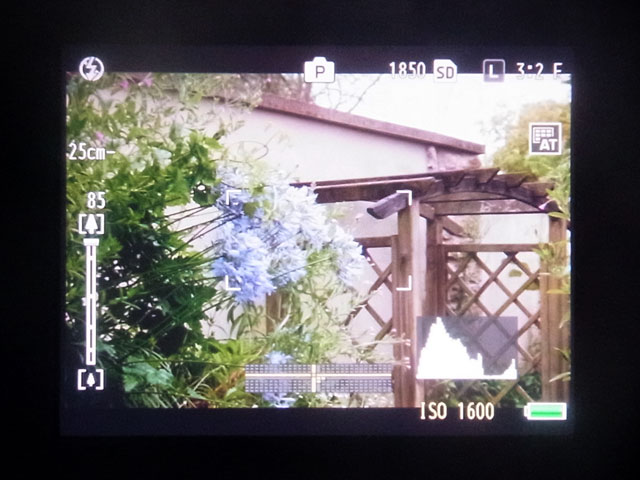 |
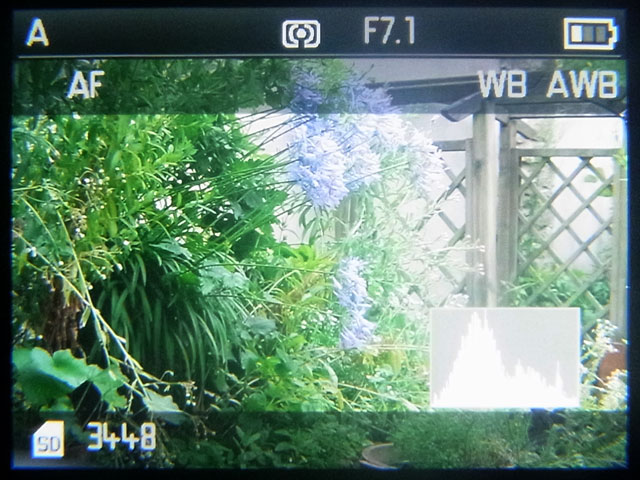 |
|
GXR with EVF2 |
X Vario with VF-2 |
Figures: Look though the the Ricoh and X Vario viewfinders (clickes images for larger versions)
Note that even on the larger versions of the photos, pixels are not discernible.
On page Manual Focusing, I compare the Ricoh EVF with the X Vario's with respect to their suitability to manual focusing (which may also depend on available focusing aids such as magnification an focus peaking). All in all, I come to the conclusion that the X Vario EVF is better suited to manual focusing, although the V Xario lacks focus peaking, and the screen magnification is of poor quality (therefore, I do not use it).
One thing that seems to present a problem to some users: The Leica X Vario EVF produces comparatively dull colors - sometimes you may have the impression that the viewfinder image is black and white. I once gave the camera to a colleague, and he was very disappointed by the viewfinder and said exactly this. You can change the color characteristics in the menu, but I refrain from doing so because I may be disappointed afterwards if the actual photos are duller than what I saw in the viewfinder - I prefer it the other way round...
As with probably every EVF, you get strong delays in low light and when you move the camera under this condition. But I am willing to accept this, knowing that one day electronic viewfinders will be better in this respect...
About the time when the Leica X Vario was released, Olympus released a new EVF (VF-4) with higher resolution (about 2.4 megapixels). Many Leica M240 and X Vario users hoped that Leica would adapt both cameras to accept the new viewfinder. But this never happened. One could read in the forums that the cameras' processors aren't powerful enough to support the new viewfinder. All in all, this is disappointing, because Leica must have known of the new viewfinder when it developed the M and the X Vario. At Photokina 2014, the new Leica X was released, which supports the new EVF that the Leica T uses (about 2.5 megapixels). Since this EVF has a different connection, it will regrettably never be possible to use this viewfinder on the X Vario. Probably one day, Leica will release a new version of the X Vario that will support newer and better viewfinders, but this does not help users of existing X Varios - who indeed spent a lot of money for the camera and may not be willing to buy a new one...
I never had the chance to compare the X Vario's EVF to one of the newer higher resolution viewfinders - expect for a recent brief encounter with the Sony A7 that a friend of mine has bought. I was surprised that the difference between the two viewfinders was not "earth-shaking". Perhaps, I should be content with what I have...
Issues
This section may be the only one that is relevant for the Olympus VF-2 viewfinder only. As is typical for the Leica X Vario, some users reported issues with the electronic viewfinder, whereas other users never had any. And as far as I remember, issues were only reported for the Olympus version of the viewfinder.
Here, I will focus on the issues that I had (and as far as I remember other users had at least some of them...). I have observed the following issues (which appeared after switching the camera on):
- The viewfinder image shows a green section on the left side or is even completely green
- The viewfinder image is completely white
- The viewfinder image shows "double images" (or double contours); in one case, only the focus rectangle showed weak double images (maybe, others were not detectable...)
- The viewfinder image shows a fine white grid pattern that is superimposed on the image
I may take photos of these phenomena, provided that this is possible, to illustrate them. But usually they happen "on tour" where I do not have a second camera with me...
How often do these phenomena appear? That is very different. Sometimes, they do not appear at all for days or weeks. On some days, they appear very often - sometimes about every second time that I switch the camera on (I usually switch the camera off after I have taken some shots to increase battery life).
How can I recover from these phenomena? At the beginning, I turned the camera off when I had issues with the viewfinder. In the meantime, I have learned that it is sufficient to switch to the LCD screen and back again. Actually, this is not much faster than turning the camera off an on again.
Up to now, I have no idea why these phenomena appear. Maybe, the contacts are corroded or the viewfinder is not exactly in place. Since switching to the LCD screen and back again does help, the contacts should actually not be the problem. Admittedly, I simply have no idea...
There is a small issue with the rubber ring at the eyepiece (you can turn the ring to adjust diopters, see Figures below): From time to time it gets lose because the camera is so tight in its bag or from other handlings, and I nearly lost it already. Moreover, from time to time I inadvertendly turn the ring and thus, change the setting and the image appears fuzzy...
 |
 |
 |
Figures: The rubber ring at the eyepiece of the electronic viewfinder Olympus VF-2 got lose already several times; you can turn the ring to adjust diopters (click images for larger versions in a new window)
Final Word
All in all, there are issues with the Olympus version of the X Vario's electronic viewfinder, and I would like to have one with higher resolution, particularly for easier manual focusing, but all in all, the viewfinder is OK and there is no way for me using the camera without it.
| 19.11.2021 |